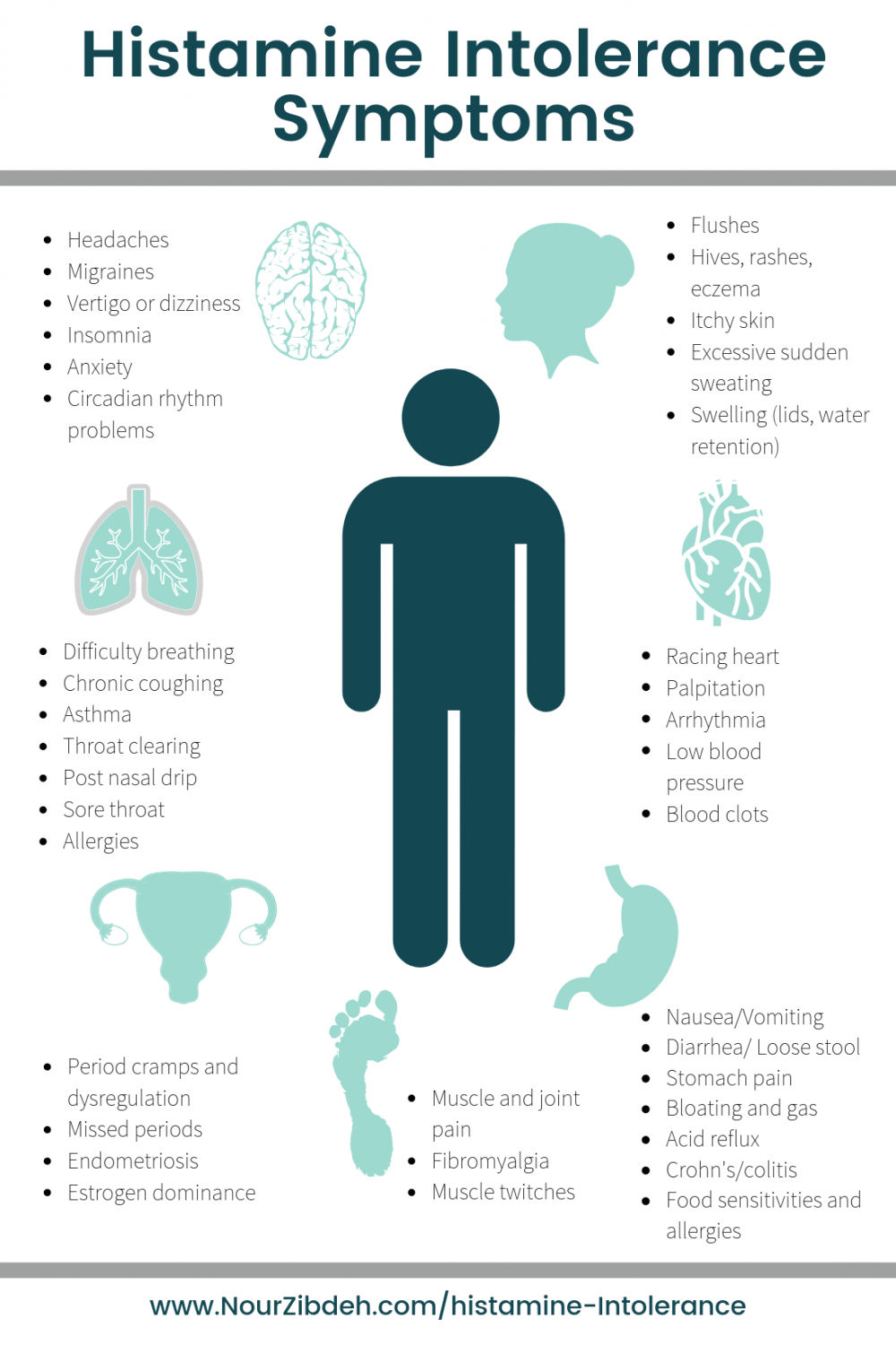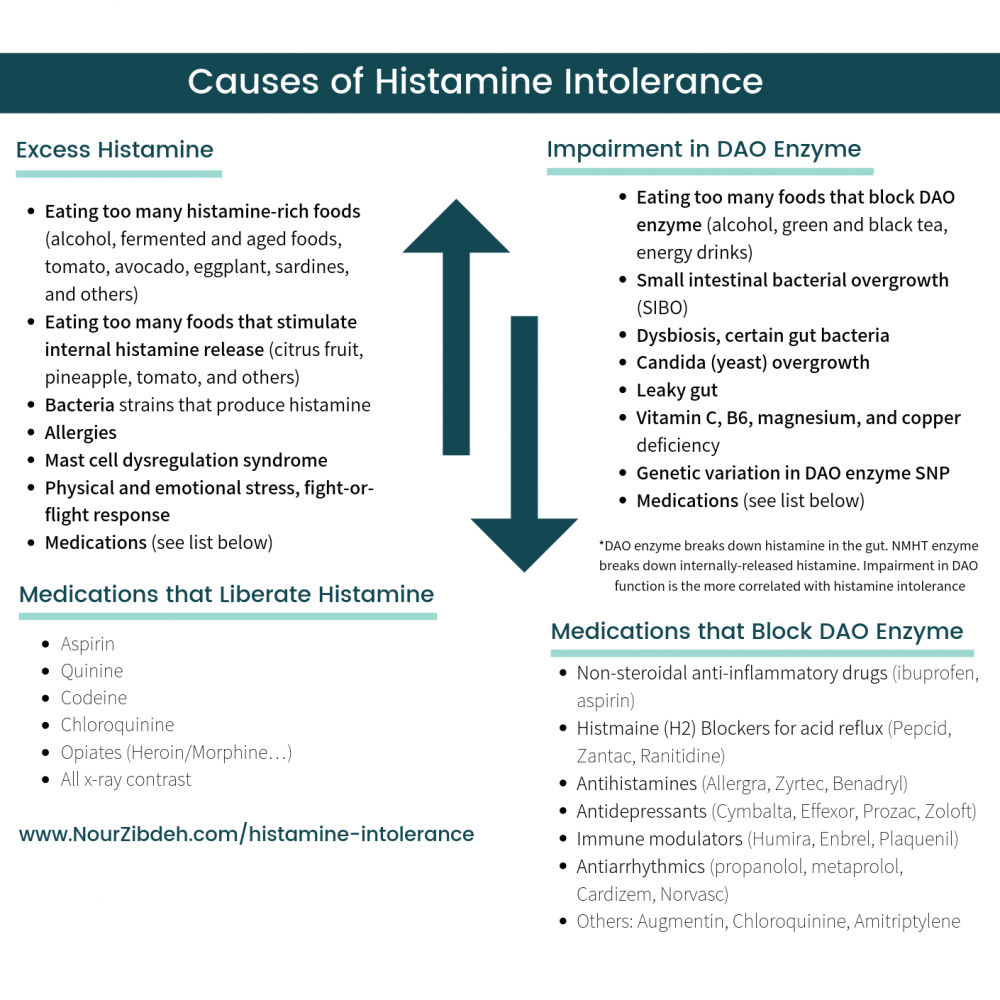What is Histamine
Histamine is a compound released by mast cells and other types of white blood cells as an immune and inflammatory response to injuries and foreign invaders. It’s needed for many important functions such digestion by stimulating hydrochloric acid release from the stomach and female reproductive health by stimulating estrogen release. It stimulates smooth muscle contractions like the ones in the intestine and uterus. When your body is faced with a pathogen or any foreign substance (like pollen and other triggers), mast cells release histamine which dilates and swells the blood vessels, allowing more white blood cells to come to site and fight the pathogen or threat. Histamine also acts as neurotransmitter, sending signals to the brain to help control body temperature, digestion, heart rate, and others.
Histamine Intolerance

Histamine Intolerance Causes
- DAO enzyme: it stands for diamine oxidase enzyme. It’s responsible for breaking down external histamine in the gut (the histamine you get from food). It’s produced mostly in the small intestine, ascending colon, placenta, and kidneys.
- HNMT enzyme: it stands for Histamine N-Methyltransferase enzyme. It’s responsible for breaking down internally-produced histamine in the intracellular space (in between the cells). It’s mostly found in the kidney, liver, spleen, colon, spinal cord, prostate, ovary, and bronchi.

Histamine Intolerance Treatment
With histamine intolerance, you can reduce and mange your symptoms by doing 3 things;
- Follow a low histamine diet
- Support DAO function with the right nutrients (vitamin C, B6, copper). People with genetic variations that cause them to make less DAO may benefit from external DAO enzymes tablets (derived from pork)
- Stabilize mast cells (stinging nettle, quercetin, vitamin C)
However, all of these are still short-term solutions.
As an integrative and functional dietitian, I want to find the root causes for the intolerances and imbalances my patients are experiencing.
Histamine Intolerance Root Causes
The best long-term solution to getting rid of histamine intolerance is to fix your gut, immune, and inflammatory problems from their root.
If you have food sensitivities, your body will continue to release histamine as a response to foods–even healthy ones. Since DAO is produced and works in the gut, problems in the small or large intestine, such as dysbiosis, leaky gut, and SIBO, can lead to impairment in DAO and histamine intolerance. If you have those, your immune cells are going to constantly fight pathogens and foods, releasing histamine. Certain types of bacteria will make histamine while other degrade it, so you have to make sure you balance your gut flora properly. I find that following a personalized food sensitivity plan along with a low histamine plan gets my patients the fastest results (in 10-30 days). You can learn more about my process for healing the gut in this free online training.
The bottomline is: you have to identify the underlying root causes of your histamine intolerance and fix them if you want to be able to enjoy a variety of foods and reduce discomfort and complications of histamine excess.
Book an Assessment and Strategy session to understand if histamine intolerance is your problem how my comprehensive and functional gut reset program can help you reverse the root causes so you can enjoy histamine food again.
Low Histamine Diet
If you want to do something about your symptoms today, start a low histamine diet. If you feel better after 14-30 days, then it’s very possible that you have a histamine problem. Many people, unfortunately, make the mistake of stopping there. They think that they need to stay on a low histamine diet forever. Some people may have to avoid large portions of the worst offenders (such as alcohol), but my philosophy is to help my patients fix the underlying problems so they can worry less about what they can or can’t eat. Use a low histamine diet as a short-term crutch until you find the answers for fixing your gut and immune system.
Avoid these high histamine foods:
- Fermented foods like sauerkraut, kimchi, and kefir
- Aged cheeses, yogurt, sour cream, buttermilk
- Alcohol, especially red wine
- Processed, aged, cured, or smoked meats
- Bone broth, bone broth powders
- Tomato, spinach, eggplant, avocado, mushroom
- Dried fruit like raisins, dates, apricots, prunes, figs
- Sardines, tuna, herring, mackerel
- Soybeans, chickpeas, and lentils
- Vinegars or vinegar-containing condiments like salad dressing, ketchup, mustard, mayonnaise
- Foods that are moldy or starting to go bad
- Yeast-containing foods and supplements, including sourdough bread and kombucha
Avoid these foods that stimulate your body to make more histamine:
- Citrus fruit (orange, grapefruit, lemon, lime, kiwi)
- Papaya, strawberry, pineapple, banana, avocado
- Nuts, especially peanuts and walnuts
- Chocolate
- Tomatoes, spinach, eggplant
- Fish and shellfish
- Pork
- Egg whites
Avoid these foods that block DAO enzyme:
- Alcohol
- Energy drinks
- Black and green tea
Need help identifying the root causes of your problems so you can fix them–correctly–once and for all? Learn more about my comprehensive integrative and functional gut healing program and book an Assessment and Strategy session.
Histamine Intolerance Summary Video
If you’d like to learn more, watch this video I posted summarized what histamine intolerance is and what to eat to alleviate the symptoms.
Histamine Intolerance Q&A
Can you test for histamine intolerance?
Yes. There are some tests that measure blood histamine level and DAO enzyme level. However, I find that the fastest way to getting some answers is following a low histamine diet. Because dysbiosis, leaky gut, and SIBO are linked to histamine intolerance, I prefer to use my patient’s resources to get these tests done to identify the real triggers so we can eliminate and correct them. If all of these come back negative and I still doubt histamine issue, I order a histamine/DAO panel.
How can you test for DAO gene?
There are some genetic tests that check for the DAO gene. Being able to break down histamine properly depends on several DNA SNPs including several methylation and MAO genes. This is something I’ve helped clients with as part of my program.
Histamine and estrogen, is there a link?
Yes! Histamine make your produce more estrogen, and estrogen makes you produce more histamine. That’s why histamine tends to be more common in women. During the phases of your menstrual cycle where your estrogen level is high, you’re more likely to notice worsening of your symptoms. Women with histamine issues, such as asthma, experience fluctuations in their symptoms based on the time of the month. Period cramps and PMS are worse during ovulation and right before your period starts, times when histamine tends to peak. Personally, with all my 3 pregnancies, I had constant congestion and runny nose, and my doctors never knew how to explain it to me. My guess (I can’t test at this point) is that my body was producing more histamine as my estrogen levels were high. You can read more about histamine and estrogen in my second article in MindBodyGreen.
Is histamine intolerance the same as food allergies or sensitivities?
No. Food allergies are IgE-mediated immune reactions. In food sensitivities, mediators are released from antibodies and directly from cells (cell-mediated), in response to food. While histamine is one of the mediators that may be released, there are others involved. I find that it’s common to have both histamine intolerance and food sensitivities at the same time, and helping reduce ALL immune reactions (both histamine release and other mediators) is the fastest way to resolved the uncomfortable symptoms.